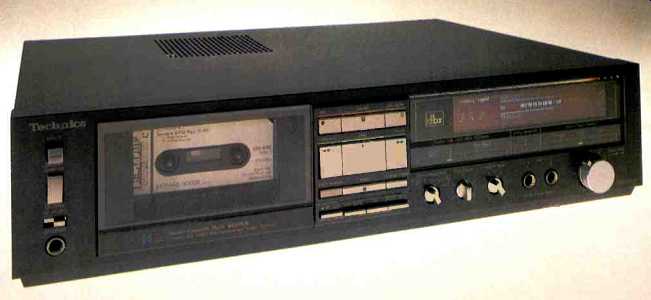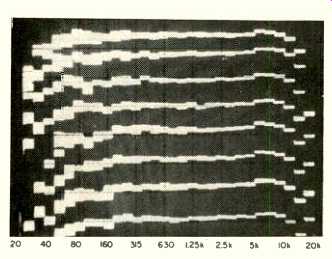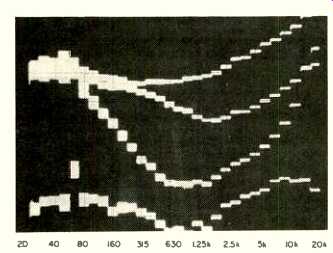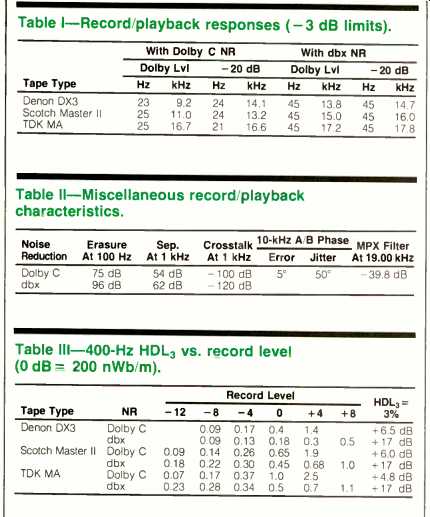
Manufacturer's Specifications:
Frequency Response: 20 Hz to 17 kHz, to 18 kHz with CrO2 tape, to 19 kHz with metal tape.
Signal/Noise Ratio: 68 dB CCIR/ARM with Dolby B NR, 76 dB with Dolby C NR, 92 dBA with dbx NR.
Input Sensitivity: Mike, 0.25, mV; line, 60 mV.
Output Level: Line, 700 mV; head phone, 130 mV at 8 ohms.
Flutter: 0.03% wtd. rms, 0.07% wtd. peak.
Wind Times: 90 seconds for C-60.
Dimensions: 16 7/8 in. (430 mm) W x 3 7/8 in. (98 mm) H x 12 7/8 in. (326 mm) D.
Weight: 14.1 lbs. (6.4 kg).
Price: $600.00.
Company Address: One Panasonic Way, Secaucus, N.J. 07094, USA.
The Technics RS-M275X deck provides a number of helpful conveniences, but the most interesting feature for many will be the inclusion of dbx noise reduction. This method offers a reduction of up to 30 dB of tape noise and expanded headroom and achieves a signal-to-noise ratio of more than 90 dBA. The dbx logo in the center of the front panel indicates the importance that Technics gives to this feature.
The user is not restricted to dbx NR, however, and the five-position noise-reduction switch has provision for Dolby B, Dolby C, dbx/tape* and dbx/disc NR (as well as off, of course). The dbx/disc setting lets the deck serve as a dbx disc decoder, and lets you simultaneously tape the un decoded signal from the disc, for dbx playback later (with dbx/tape). However, you can't decode for both play and recording. Status lights remind the user of the switch set ting, and the one for dbx/disc is a warning red, calling attention to the fact that this is not a normal recording or playback mode.
The knobs for the NR switch and the bias-adjust and output-level pots are small, but the bar design makes adjustment easy. The medium-size knobs of the dual-section, input-level control have a good design for interchannel level adjustments, and the friction coupling makes for simple setting of levels for both channels. The peak-responding, horizontal bar-graph level meters have 18 segments for each channel: Blue-white from "- 40" to "0," orange for " + 2" to " + 8," and red for " + 10," " + 12" and " + 18." A parallel set of red reference bars are illuminated only with dbx NR, indicating that such high recording levels are acceptable only when using dbx NR encoding, with its 2:1 compression. The meters also have a short peak-hold at any level of-20 dB or above, an aid to setting accurate levels.
The logic-controlled tape-motion switches are actuated by large, light-touch plates, with indicators for "Rec," "Pause," "Play" and "Stop." The use of "Rec Mute' automatically switches the counter/time display to a minute-second readout giving the duration of muting, second by second--a useful scheme. "Tape/Time" allows switching between the normal three-digit counter and a time-remaining mode. The latter function can be set to count down in minutes and seconds for any standard-length cassette from C-30 ( 15:00 start time) to C-120 (60:00), provided, of course, that record or play starts at the beginning of the cassette. The "Set" button is also used in conjunction with "Music Select," which results in the display of two zeros, to set the number of selections that will be skipped in "Intro Search" mode. "Intro Search" fast-winds to the start of each selection in turn, playing 10 seconds before winding to the next piece; this is useful when the location of desired selections is uncertain. "Memory Repeat" calls for the deck to go automatically into play when rewound to "000." An indicator at the top of the counter/timer readout shows when this mode is active.
"Eject" tilts the cassette carrier out smoothly for loading and unloading. The door/cover snaps off for improved ac cess for maintenance tasks. The timer and power switches and the phone jacks for headphones and left- and right-channel microphones complete the front-panel facilities.
The line-in/line-out phono jacks are on the rear panel. As was expected, the Technics deck contained quite a bit of circuitry with several p.c. boards, including a large, horizontal one which also served as the motherboard for three medium-size vertical cards. The cards appeared to be phenolic-type material, rather than the more desirable, and higher cost, glass-epoxy type. The soldering was excellent, the parts were clearly identified, and adjustments were also labeled with their functions. Inter-card connections were made primarily with the use of multi-pin plugs. The three-motor, direct-drive transport was very quiet in operation.
The main chassis and frame unit was of molded, ribbed plastic. By itself, the unit was fairly rigid, but stiffness was considerably improved with the steel top and side cover in place.
Measurements

Fig. 1--Frequency response with Dolby C and with dbx NR (dashed line)) using
Type I (Denon DX3), Type II (Scotch Master II) and Type IV (TDK MA) tapes.

Fig. 2--Record/playback responses with TDK MA tape using pink noise at 0,
+5, +10 and +15 dB re: Dolby level. Top four with Dolby C NR, bottom four
with dbx. (Vertical scale: 5 dB/div.)

Fig. 3--Relative noise levels in third-octave bands for Scotch Master II
with, from top, no NR, Dolby B, Dolby C, and dbx. (Vertical scale: 5 dB/div.)

Table I--Record/playback responses (-3 dB limits).
Table II--Miscellaneous record playback characteristics.
Table III--400-Hz HDL3 vs. record level (0 dB = 200 nWb m).

Table IV-Signal/noise ratios with IEC A and CCIR ARM weightings.
Table V--HDL3 vs. frequency at 10 dB below Dolby level.
Table VI--Input and output characteristics at 1 kHz.
The playback responses were quite good at both 70-µS and 120-µS equalizations, although response was more than 2 dB down at both ends with 70-uS EQ. The bias adjust pot made it possible to get flat responses with most tapes without NR, but the lack of means to adjust record sensitivity reduced the number of tapes that had good noise-reduction tracking. Matching was quite good with BASF Professional I Super, Professional II and Metal IV, Denon DXM, Fuji FR-I and FR-II, JVC ME. Maxell XL II-S, Sony UCX-S and TDK D, AD, and SA. The results appeared best with Denon DX3, Scotch Master II and TDK MA, and these tapes were used for the detailed testing that followed.
Swept-frequency record/playback responses were plot ted (Fig. 1) for the three tapes at Dolby level and 20 dB below that both with Dolby C and dbx NR. With the Type I Denon DX3, responses were also run at 5 dB above Dolby level. In general, the responses were quite good between 60 Hz and 10 kHz or more, but the boosts with TDK MA and Dolby C NR at low and high frequencies were greater than desirable. At the frequency extremes, points were reached where there were fast roll-offs in the dbx responses. (In private communications, it was learned that the low-frequency roll-off was caused by a high corner frequency on the coupling network after the dbx circuit. At the time of writing, a decision had not been made on if, or what, corrective action might be taken. The roll-offs at the high end were caused by the dbx system's operating on the sweeping single tone as the response deviated from flat. As the dbx scheme operates on broadband level sensing, the responses are best checked with broadband signals such as pink noise.) Table I lists the results for the three tapes with the two NR schemes, using the swept sine wave for Dolby C and pink noise for dbx. (It should be noted that the sine wave is more of a challenge to high-frequency head room than is pink noise for the same meter level.) Not listed are the figures without NR, which met specification.
Figure 2 shows the record/playback responses with pink noise with the record levels increased in 5 dB steps from meter zero to +15 dB. The bottom set of four were made with dbx NR, and good tracking and lack of compression are obvious. In the top set of four, made with Dolby C NR, there is about 0.5 dB compression at +5 dB, 1 dB compression at +10 and almost 3 dB compression at +15 dB.
The anti-saturation scheme of Dolby C NR prevents high end roll-off, but the dbx NR is clearly more resistant to high level compression Table II lists some miscellaneous record/ playback characteristics, and they are all excellent except for somewhat high phase jitter at 10 kHz. Take note of the fact that dbx NR improved the erasure, crosstalk and separation performance--the result of the 1:2 expansion in play back decoding.
Table III shows the HDL3 values for the three tapes, with both NR schemes, over a range of recording levels. The points at which the third harmonic level reached 3% are also shown. The distortion was quite low with Dolby C NR, especially with the Denon tape. With dbx NR, the measured distortion was higher at low record levels (Scotch Master II and TDK MA), but much lower at high record levels--both results of the 2:1 encoding (and the 1:2 decoding). The HDL3 points with dbx NR appeared to go as much with output clipping effects as with tape-saturation limits. The signal-to-noise ratios with Dolby C and dbx NR were measured with both IEC A and CCIR/ARM weightings with reference to both Dolby level and the 3% points. Table IV lists the excellent figures for all conditions, and the results of over 90 dB with dbx NR are certainly worthy of particular attention.
Table V shows that at medium levels (-10 dB) with Scotch Master II, the distortion across the band, though low, was roughly two times greater with dbx NR than it was with Dolby C NR. Figure 3 shows the tape noise spectrum in third-octave bands (top to bottom) without NR, with Dolby B, with Dolby C and with dbx NR. The successive reduction in noise levels is very apparent, perhaps made more so by the use of a 'scope setting of 5 dB/division for a total "window" of just 40 dB.
Table VI lists the basic input and output characteristics of the Technics deck, all very good and substantially to specification. The input and output pot sections tracked within a dB for at least 45 dB down from maximum, quite good overall. The output polarity was the same as the input in record mode, but reversed in playback. The thresholds of the bar-graph level meters were accurate from "- 10" to " + 18," but "- 40" did not turn on until-29 dB actual. The Dolby symbol appeared to be lined up with " + 2," but the standard play level was closer to " + 4." The dynamic response to a 5-kHz tone burst was slower than IEC standards, but did reach meter zero with just 15-mS duration.
Return time for 20 dB was about 0.5 second, a bit fast, but the 1-second peak holds seemed helpful. The frequency response was 3 dB down at a rather high 72 Hz and at a normal 25.6 kHz.
Tape motion was very steady in all respects. Flutter was just slightly over the specified 0.03% wtd. rms (0.034%) and weighted peak flutter was only 0.05%, less than the 0.07% specification. The tape speed vs. time appeared to vary less than 0.01%, and there was no measurable change in playing speed with any line voltage from 110 to 130 V.
Wind times for a C-60 were 84 seconds--within specification, but slower than most decks. Reaching a full stop from fast wind or changing modes required 1 second or less, though reaching a full stop from play took about 4 seconds. It was not possible to go directly into record from play mode (flying-start recording). This may represent a limitation in technique for some users, and I like the feature when it is included on a tape deck.
Use and Listening Tests
I judged the owner's manual one of the better ones I've seen lately. The text was very good, with the illustrations well tied to the discussion. Operational steps were shown in conjunction with call-outs on a front-panel layout, a good scheme. Two criticisms: There could have been more detail on setting levels in the various modes, and the listing of possible tapes includes some that would not perform too well with noise reduction.
With the door cover removed, access for maintenance tasks was one of the best seen to date. The controls and switches were all completely reliable, with the exception of the "Stop" status light which went out in the last hours of testing. A number of the convenience functions were utilized quite regularly, especially the remaining tape-time display, "Intro Search" and "Memory Repeat." Timer start checked out just fine. There were no record or pause clicks even detected, and the stop noise was just a soft clunk down into tape noise.
The listening tests used discs, a number of them dbx encoded. A couple of these discs were played using the deck's decoder, and it sounded like an exact match to a separate dbx 128 decoder. Record levels were set quickly and accurately with the bar-graph meters, benefiting from the peak holds as expected. Much of the reproduction was certainly very good, but there were some differences ob served. For example, the results with dbx were very impressive, tape playback showed as little noise as the original disc with very little modulation, and high record levels were certainly quite possible. Instrumental sound seemed to be very slightly pointed, however, and Dolby C NR matched the original better in this respect. In a recording of Strauss' Also Sprach Zarathustra, the dbx NR playback did not keep the impact of the low organ tones, although the sound was still quite impressive. All in all, the Technics RS-M275X offers very good to outstanding performance in all areas--with Dolby B, Dolby C and dbx NR.
--Howard A. Roberson
(Audio magazine, March. 1983)
Also see:
Technics RS-M95 Cassette Deck (Sept. 1981)
Technics RS-B100 Cassette Deck (Equip. Profile, March 1985)
= = = =